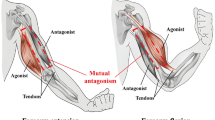Abstract
This study describes the trajectory control of biomimetic robots by developing human arm trajectory planning. First, the minimum jerk trajectory of the joint angles is produced analytically, and the trajectory of the elbow joint angle is modified by a time-adjustment of the joint motion of the elbow relative to the shoulder. Next, experiments were conducted in which gyro sensors were utilized, and the trajectories observed were compared with those which had been produced. The results showed that the proposed trajectory control is an advantageous scheme for demonstrating human arm movements.
Similar content being viewed by others
Explore related subjects
Discover the latest articles, news and stories from top researchers in related subjects.References
Uno Y, Kawato M, Suzuki R (1989) Formation and control of optimal trajectory in human multi-joint arm movement. Biol Cybern 61:89–101
Alexander R (1997) A minimum energy cost hypothesis for human arm trajectories. Biol Cybern 76:97–105
Lan N (1997) Analysis of optimal control model of multi-joint arm movements. Biol Cybern 76:107–117
Wada Y, Kaneko Y, Nakano E, et al (2001) Quantitative examination for multi-joint arm trajectory planning using a robust calculation algorithm of the minimum commanded torque change trajectory. Neural Networks 14:381–393
Atkeson C, Hollerbach J (1985) Kinematic features of unrestrained vertical arm movements. J Neurosci 5–9:2318–2330
Flash T, Hogan N (1985) The coordination of arm movements: an experimentally confirmed mathematical model. J Neurosci 5–7:1688–1703
Richardson M, Flash T (2002) Comparing smooth arm movements with the two-thirds power law and the related segmented-control hypothesis. J Neurosci 22-18:8201–8211
Hollerbach J, Atkeson C (1987) Deducing planning variables from experimental arm trajectories: pitfalls and possibilities. Biol Cybern 56:279–292
Zhou H, Hu H (2007) Internal sensors for motion detection of human upper limbs. Sensor Rev 27(2):151–158
Sasada D, Kashima T, Iwaseya M (2008) Analysis of arm trajectory based on measurements utilizing inertial sensors. Third Asia International Symposium on Mechatronics, pp 399–402
Plamondon R, Feng C, Woch A (2003) A kinematic theory of rapid human movement. Part IV. A formal mathematical proof and new insights. Biol Cybern 89:126–138
Kashima T, Isurugi Y (1998) Trajectory formation based on physiological characteristics of skeletal muscle. Biol Cybern 78: 413–422
Author information
Authors and Affiliations
Corresponding author
Additional information
This work was presented in part at the 16th International Symposium on Artificial Life and Robotics, Oita, Japan, January 27–29, 2011
About this article
Cite this article
Kashima, T., Iwaseya, M. Trajectory control of biomimetic robots for demonstrating human arm movements. Artif Life Robotics 16, 338–342 (2011). https://doi.org/10.1007/s10015-011-0944-6
Received:
Accepted:
Published:
Issue Date:
DOI: https://doi.org/10.1007/s10015-011-0944-6




